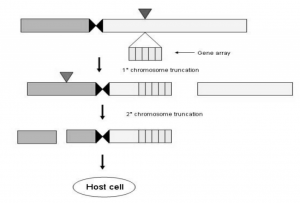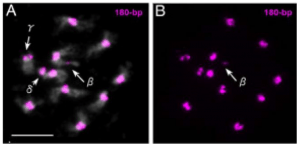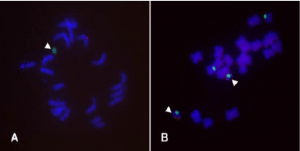Minichromosomes: A Minichromosome is an extremely small version of a chromosome that has been produced by de novo construction using cloned components of chromosomes or through telomere-mediated truncation of endogenous chromosomes. They depend on functional DnaA and DnaC products, de novo protein synthesis and RNA polymerase mediated transcription for initiation of bi-directional replication; thereby resembling their chromosomal counterparts. Minichromosomes are also known to be enriched with transposable or repetitive elements.

Genetic engineering is a powerful tool for improving crop quality and productivity and reducing labor and resource utilization of farming. Traditionally genetic engineering is done by either Agrobacterium-mediated transformation or direct transformation by particle bombardment using a gene gun. These methods have several limitations, since they allow insertion of single or few genes at random genomic positions and require the simultaneous expression of multiple genes; but complex or combined traits cannot be transferred in a coordinated manner.
These methods are labour-intensive and time-consuming processes and also require highly skilled personal and significant input for desirable results. Furthermore, a high number of phenotypically abnormal plants are recovered and often usefulness of host genome is seriously disturbed. Minichromosome technology provides one solution to the stable expression and maintenance of multiple transgenes in one genome. In addition, plant artificial chromosomes or engineered minichromosomes represent a potentially powerful research tool for understanding chromosome structure and functions.
Since it is technically difficult at present to introduce large repetitive DNA molecules into plant cells efficiently; minichromosomes, either those which occur naturally or those that are induced by irradiation, are another important alternative choice for determining minimum functional sizes of the centromeres and for constructing artificial chromosomes. Mammalian artificial minichromosomes also have several potential biotechnological and therapeutic applications arising from their ability to exist episomally, carry large DNA inserts, and allow expression of genes independently of the host genome.
Minichromosome in plants
Minichromosomes technology is well known and successfully used in humans, fungi, yeast and other species as discussed above. In plant systems minichromosomes were discovered in the late nineties. Earlier the function and use of minichromosomes were not clearly known or reported in primary literature. Later it was discovered that minichromosomes are very useful to understand the basics of chromosomal structure and for the purpose of use in genetic engineering of plants. Recently, the Minichromosome technology offers enormous opportunities to improve crop plants.
Minichromosomes in Arabidopsis
The DNA structures of centromeres have been studied extensively in case of Arabidopsis, Since very small genomes (like that in Arabidopsis) has relatively small chromosomes; the DNA is estimated to be 17.5–29.1 Mb only; but it is still large to be easily manipulated in vitro. In teleocentric line of A. thaliana, a minichromosome was identified through Fluorescence In Situ Hybridization (FISH) approach and it revealed that it was from the short arm of chromosome number 4.
The size of this “mini4S” chromosome was estimated to be ~7.5 Mb on the basis of previously reported data and the amount of the centromeric major satellite (180-bp family) present, which was determined to be about 1 Mb, or about one third of that in the normal chromosome 4. The researchers also reported the size, centromeric function and the meiotic behavior of minichromosome. Recently, two more minichromosome (α, β and δ) have also been discovered by the same research group. These two minichromosomes were found in a transgenic Arabidopsis plant produced by in planta vacuum infiltration technique.

Minichromosome in maize
The maize B chromosome exists in only some varieties of maize. The properties an function of B chromosomes in maize were discovered by Carlson and Roseman (1992) and rediscovered by Ronceret et al., in 2007 in the light of mini chromosomes. Recently, maize minichromo-somes were engineered by modifying A and B chromosome using telomere-mediated chromosome truncation. These minichromosomes were transferred to a diploid background by repeated backcrossing and were stably maintained. By using the same set of constructs, they targeted the maize B chromosome with biolistic-mediated gene transformation. Truncated B chromosomes were recovered with much greater efficiency. The sizes of the mini B chromosomes ranged from very small to almost the full size of the normal B chromosome.
Although they produced A and B minichromosomes by this method but they were more interested in B chromosome based minichromosomes, because B chromosomes has many interesting properties (Kato et al., 2005), such as: (i) the truncation of B chromosomes will not cause developmental or transmission problems as A chromosomes do; (ii) the B chromosome derivatives can be distinguished by their shape and the presence of a B chromosome specific repeat in and around the centromeric region; and (iii) the size of mini B chromosomes is not crucial because there will be no residual endogenous genes that might interfere with plant development and transgene expression. Recently, Carlson et al., (2007) developed maize minichromosomes (MMCs) and demonstrated that autonomous MMCs can be mitotically and meiotically maintained.

Future prospects of minichromosomes
Engineered minichromosomes can be used in all areas of future genetic engineering. Minichromosomes can be used in site-specific recombination or retrofitting the minichromosomes with additional foreign genes (Ow 2007). Minichromosomes can also be used for gene stacking in plants, which is currently considered as challenging for plant biotechnology (Halpin 2005). Minichromosomes can also facilitate an understanding of fundamental questions about chromosomal structure and function, such as for centromeres, neocentromeres, B chromosome non-disjunction as well as chromosomal behavior in general., In addition, it might be possible to develop a mini B chromosome-based genomic cloning system for capturing large chromosome fragments.
The B chromosomes in maize can accumulate up to many copies. Because mini-B chromosomes can non-disjoin in the presence of normal B chromosomes, it may be possible to accumulate higher numbers of mini B chromosomes than normal B chromosomes. Recently a private company called CHROMATIN® got three patents from “United States Patent and Trademark Office” for their minichromosome technology. The Chromatin® technology uses a single heritable piece of the plant’s own DNA to generate a minichromosome.
The issued patents describe minichromosome DNA sequences and the use of those sequences to incorporate genes to the plants. Chromatin® Inc. develops and markets novel proprietary technology that enables entire chromosomes to be designed and incorporated into plant cells. These minichromosomes can be used in any plant or crop to simultaneously introduce multiple genes while maintaining precise control of gene expression. Chromatin’s minichromosome technology can be used to deliver genes that benefit the agricultural, nutritional, energy, pharmaceutical, and chemical sectors.
